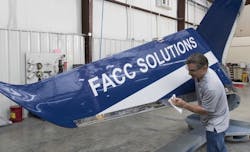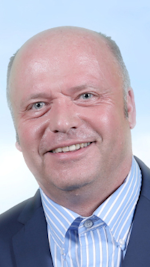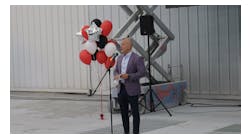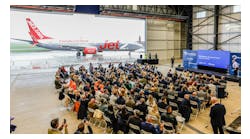“Never scrap your composite component again,” says Christian Strobl, director of component maintenance at FACC Aftermarket Services –Repair Refurbish Replace. “Whatever may come, we put all our know-how and passion into providing the best and fastest solution to our customer." These two statements say it all in how people at FACC in Austria and in the U.S. think and act.
Every second, there is an aircraft departing or landing with FACC technology on board, according to FACC. For more than 30 years, the company says it has been a leading force in the development and production of components and systems made of composite materials. According to FACC, no other organization in this industry has its lightweight composite components installed on as many aircraft models. FACC is an approved service provider, too.
FACC's three divisions Aerostructures, Engines and Nacelles, and Cabin Interiors, offer a broad variety of composite components from B737NG winglets and A320 Sharklets, B787 and A350 translating sleeves to A320 XL Airspace, as well as complete business jet cabin interiors manufactured for all known OEMs in the aviation industry. Cabin interiors are also manufactured for freighter aircraft, for passenger aircraft conversion, and even for rotorcraft.
Aftermarket Services is the FACC's “youngest kid” where the company is focusing and intensifying its maintenance activities increasingly aiming at repair of components.
“Agility, flexibility, and simplicity are the three values that are expected to contribute to the growth of FACC's aftermarket business,” says Christian Mundigler, vice president aftermarket services, who joined FACC in February 2018. “To this end, FACC can rely on locations on three continents and a tight-knit network of partners. Over the next few years, this network will be further strengthened while extending the range of services and products offered, as well as expanding individual locations.”
The first stone was laid in May 2018 at the location for component repairs in Wichita, KS: The plant was expanded to 60,722 square feet in order to accommodate the steep growth in the aftermarket services business in North, Central, and South America.
Several months ago, during the writer's visit to FACC in Austria, he had the opportunity to walk through three production sites located close to the German border. AMT already described what FACC is manufacturing in its plants in our January/February 2019 issue. Repair of components is of increasing interest, so FACC is expanding this activity.
Composite Repair
Understanding the complexity in the repair of composite components, FACC decided to bring this into the new Aftermarket Services business segment as a true one-stop composite shop and original component manufacturer. FACC is globally offering the repair and refurbishment for all composite components produced in-house. Holding an EASA Design Approval account Part 21J, including the approval to perform even “Major Changes,” FACC is completely independent and capable to offer up to heavy repairs for any damaged composite components.
Each composite product that is manufactured in one of the FACC plants in Austria is typically laid up in a clean room environment and cured in an autoclave process. Depending on used materials and OEM-requested process, an autoclave cure lasts between three and eight hours. The next process step is the machining of the part to meet engineering requirements. Following this, contour CNC process to meet a -/+ 0.75 [mm] tolerance, 100 percent of the parts are going through nondestructive testing (NDT) to ensure 100 percent part integrity. This means that no foreign object (FOD or foreign object defect) in the part lay-up or other imperfections should be found in the finished part. FACC inspects all manufactured parts for imperfections of minimal dimensions of 6.0 x 6.0 mm. Most common NDT methods are ultrasonic techniques performed either by hand called an A-Scan or on a five-axis C-Scan device. Based on the engineering requirements, Xray or thermography techniques are also used at FACC.
In a case a deviation to drawing requirements is found in this nondestructive testing process at FACC, a material review board (MRB) process gets started.
The goal of this MRB process is to bring the part back to engineering requirements. In the initial airworthiness setting, parts are produced to Part 21.G requirements. An investigation is carried out by a MRB engineering team based on NDT results. In most cases, where an imperfection is found in the ply layup, it is necessary to remove this imperfection, which is in a brother view either a dis-bond or foreign material inclusion which is greater than 6.0 x 6.0 mm. To remove this detected foreign material, it is necessary to scrap all overlaying material ply by hand. This process step is sometimes a very long process because some aircraft structures consist of more than 50 layers of composite material. After this exercise, another NDT inspection is necessary to ensure that all foreign objects are removed.
Based on the results of the FOD removal process, the MRB stress engineer has developed a repair ply buildup scheme. This scheme defines ply materials and weaving directions of the material to ensure proper strength and geometrical fit of the repair for the full product life-cycle. The layup process itself is again carried out by hand layup in a clean room environment and all further inspection steps are performed as initially defined in the initial airworthiness part design.
It is vitally important to have a lean process landscape to fulfill the requested and expected turnaround times. The process is divided in an incoming inspection time which takes up to five days and a repair time of up to 25 days, which sums up in a turnaround time of not more than 30 days. Dedicated MRO/Part 145 composite technicians and certifying personnel are available for each of the process steps to ensure a seamless flow of the repair at FACC. The repair team is supported by 20 autoclaves in house, as well as the latest NDT techniques such as thermography and a wide range of CMM measurement devices to ensure that the repair meets all requirements. A viable ERP solution supports the interaction with the repair team in house as well as to report the status to the customer. With all that said, FACC Aftermarket Services provides OEM proven repair solutions to the customer.
Small Parts with a Big Impact
“In order to be close to our customers — airline customers as well as MRO stations — FACC opened subsidiaries like FACC Solutions Inc. in Wichita and FACC Solutions Inc. in Montreal, besides the headquarters location FACC AG in Ried im Innkreis, Austria,” Strobl states.
“FACC in Austria currently holds Part 145 approvals from EASA, FAA, TCCA, and CAAC before finalization,” Strobl continues. “FSI-Wichita with FAA and EASA Part 145 approvals was originally established to perform modifications from blended winglets to Split Scimitar winglets for Aviation Partners Boeing Inc. but the huge market demand for winglet repairs convinced us in an early stage to expand our business model and capability list toward repairs."
Since the startup of its component repair station in 2014, FACC Solutions Inc. (FSI), located in Wichita, KS, has completed more than 2,000 737NG and 757 winglet modifications and repairs. FSI has successfully repaired 767 blended winglets. If a Sharklet becomes damaged, a quick and competent repair could be performed by FACC.
"After being very successful in winglet repair on each side of the Atlantic — FACC´s location in Wichita for instance has grown by 200 percent since 2014 employing more than 40 experts — it was obvious that FACC should extend its services further. Hence, FACC Aftermarket Services Department was established and officially launched in April 2018.” Strobl continues, “Small parts with a big impact: In order to reduce fuel consumption, most aircraft types rely on winglets to reduce aerodynamic drag. Winglets are parts to be attached to the aircraft as a wingtip device. By reducing aerodynamic drag, they can reduce fuel consumption by up to six percent.
For the aircraft operators, the savings through repairing the winglets and Sharklets instead of buying new parts, could in some cases reach 50 to 60 percent. Every repair is a single event has to be judged carefully, from case to case. Therefore, the only general rule is: After the five days inspection the confirmation of the "Rough Order of Magnitude" offer can be made, and then 25 days turnaround time for repair have to be considered.
FACC is in the process of working on rotable parts for the airline customer, so that FACC can offer turnkey solutions for a lease model where the rotable will stay on the aircraft for the duration of the repair or an exchange model where the rotable stays on the aircraft. The first focus products are wing components like winglets for B737NG fleet and Sharklets for the A320 aircraft family.
FACC Growth Path
Expanding its network and capabilities as well as strengthening its external presence is not the end of the story when it comes to its growth strategy. Today, FACC Aftermarket Services offer OEMs and airlines a broad range of services and products — from maintenance and repair through to upgrading and modification of existing cabin interiors and structural aircraft components. In the medium term, FACC will continue to expand this portfolio. By integrating new products and services, the business unit is focusing on expanding its customer base and creating more customer proximity. The mission: New products for existing customers. New customers for existing products.
“According to current forecasts,” Mundigler says, “the global MRO business is projected to grow by an average of 4.6 percent over the next 10 years. With its new Aftermarket Services business unit, FACC is positioning itself in order to partake in this market potential and tap into new groups of customers.





